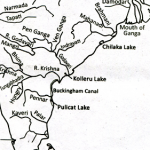- What are Genetically Modified Organisms (GMOs) and GM crops?
- GMOs can be defined as organisms in which the genetic material (DNA) has been modified in a way that does not occur naturally by mating and/or natural recombination.
- The technology is often called “modern biotechnology” or “gene technology”, sometimes also “recombinant DNA technology” or “genetic engineering”.
- It allows selected individual genes to be transferred from one organism into another, also between nonrelated species. Foods produced from or using GM organisms are often referred to as GM foods.
GM crops in India
- At present only GM Cotton is allowed to be cultivated in India.
- Bt Brinjal, a form of eggplant, was set for approval in 2010 but because of public concerns, the government refused to allow it to be commercialized. It is successfully grown in Bangladesh.
- Currently, the government is examining a proposal on GM mustard seeds despite there being severe opposition to it among environmental activists.
Proponents of GM
- GM Mustard hybrid can improve crop productivity and raise farmers’ income. Indian farmers also have the right to scientific solutions that can help them to enhance their crop productivity, incomes and livelihoods.
- India’s dependence on edible oil imports has made it necessary to harness GM mustard. Annually, India spends about $ 12 billion on imported edible oil. The edible oil deficit will continue to widen with the increase in population and per capita income. To address this challenge, India needs to increase productivity of oilseeds crops. GM mustard can improve the yield of mustard in India, which is almost stagnant since the last two decades.
- GM crops are already widely used for non-edible crops and has seen a huge improvement, for example, in pesticide and insecticide usage. If GM can help in reduce the usage of pesticide and insecticide, that might be a huge betterment to food supply.
- With a rapidly increasing population, stagnant grain production and rapid industrialization reducing available land, scientists in India and around the world, are looking to the potential of genetically engineered crops. They show dramatically increased yields because they are grown with fewer weeds and can be engineered to resist pests.
- India introduced Bt cotton seeds in 2002. It has greatly reduced the use of toxic pesticides. Bt cotton produces a common soil bacterium, Bacillus Thuringiensis (Bt). It is a natural pest repelling bacteria that is toxic to many worms and pests that can harm the crop but is not hazardous to humans. Bt is widely sprayed on crops by organic farmers as a pesticide. As a result of the adoption of Bt cotton, India is now the largest cotton producer in the world.
Opponents of GM
- GM crops can effect the entire ecosystem if companies manufacturing GM crops are given access to Indian market. The ecosystem, which includes animals and plants as well, is affected and this has stopped most of Europe from using GM crops. These crops enhance serious risks to the health of consumers as well as that of soil.
- They also increase the cost of cultivation manifold, while transferring the same to corporate as immoral profits.
- Most farmers take debts to buy improved seeds because of higher yields and lower expensive inputs like pesticides. Higher debt levels have been responsible for a rapid increase in farmer suicides. India’s tryst with GM crops has landed cotton farmers in a deep crisis. Any attempt to release more transgenic crops in India would endanger not only farmers but the country’s trade, exports and the environment as well.
- Due to ignorance, 11 percent of arable land in India has already come under GM cotton (Bt Cotton), and now a campaign has been initiated to give market access to mustard which has to be resisted.
- GM Mustard is a negative value crop while organic mustard will have huge value appreciation that is advantageous for the farmer, trader and consumer. GM Mustard is less productive than at least five different varieties.
- There is a pressure on Genetic Engineering Appraisal Committee (GEAC) under Ministry of Environment and Forest from companies like Monsanto, Syngenta and Bayer. The GEAC examines the scientific merits of releasing GM seeds into the environment. Its clearance is mandatory for testing GM crops in farmer fields.
- Research should be focused on indigenous variety of crops instead of introducing GM crops by subsidizing MNCs. The government should relaunch the Technology Mission on Oil Seeds, with a focus on organic farming, higher assured prices, and increased protection from cheap imported oil.
- The Centre’s preliminary clearance to GM Mustard, named Dhara Mustard Hybrid-11 (DMH-11) contravenes a 2013 report by a Supreme Court-appointed technical expert committee. The committee had said that herbicide-tolerant crops ought not to be permitted in India. One of the genes in DMH-11 contains a gene called ‘bar’ that confers herbicide tolerance. Such a property makes plants resistant to a class of weedicide containing the chemical glufosinate. Glufosinate is toxic and makes farmers dependent on certain brands of crop chemicals.











